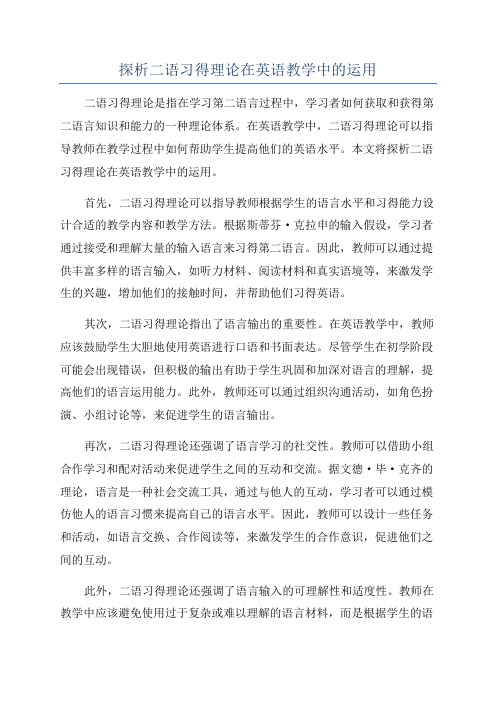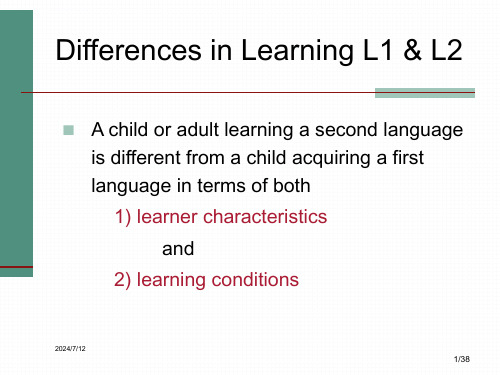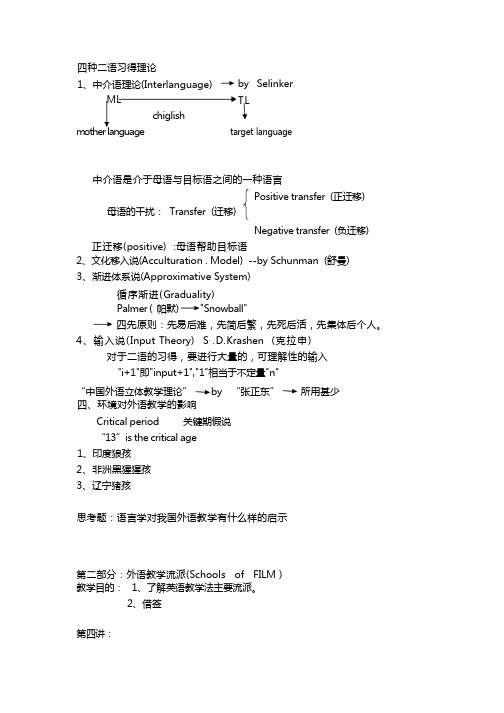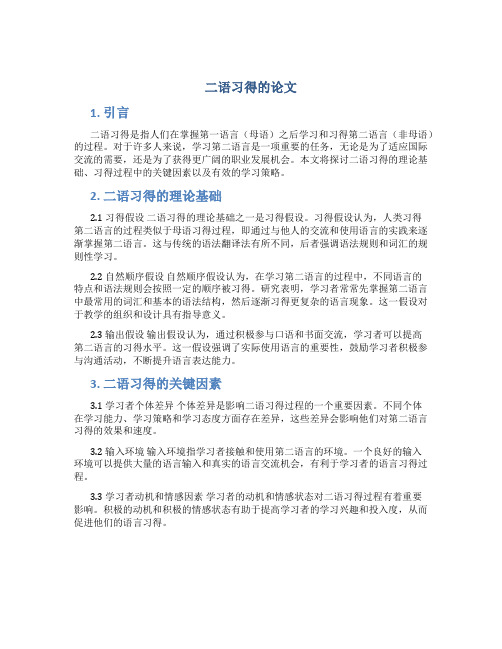二语习得
探析二语习得理论在英语教学中的运用

探析二语习得理论在英语教学中的运用二语习得理论是指在学习第二语言过程中,学习者如何获取和获得第二语言知识和能力的一种理论体系。
在英语教学中,二语习得理论可以指导教师在教学过程中如何帮助学生提高他们的英语水平。
本文将探析二语习得理论在英语教学中的运用。
首先,二语习得理论可以指导教师根据学生的语言水平和习得能力设计合适的教学内容和教学方法。
根据斯蒂芬·克拉申的输入假设,学习者通过接受和理解大量的输入语言来习得第二语言。
因此,教师可以通过提供丰富多样的语言输入,如听力材料、阅读材料和真实语境等,来激发学生的兴趣,增加他们的接触时间,并帮助他们习得英语。
其次,二语习得理论指出了语言输出的重要性。
在英语教学中,教师应该鼓励学生大胆地使用英语进行口语和书面表达。
尽管学生在初学阶段可能会出现错误,但积极的输出有助于学生巩固和加深对语言的理解,提高他们的语言运用能力。
此外,教师还可以通过组织沟通活动,如角色扮演、小组讨论等,来促进学生的语言输出。
再次,二语习得理论还强调了语言学习的社交性。
教师可以借助小组合作学习和配对活动来促进学生之间的互动和交流。
据文德·毕·克齐的理论,语言是一种社会交流工具,通过与他人的互动,学习者可以通过模仿他人的语言习惯来提高自己的语言水平。
因此,教师可以设计一些任务和活动,如语言交换、合作阅读等,来激发学生的合作意识,促进他们之间的互动。
此外,二语习得理论还强调了语言输入的可理解性和适度性。
教师在教学中应该避免使用过于复杂或难以理解的语言材料,而是根据学生的语言水平和学习需求选择合适的材料。
同时,教师还可以通过提供适当的文化背景知识和语言学习策略来帮助学生更好地理解英语,提高他们的语言运用能力。
最后,二语习得理论还提出了错误处理的重要性。
学习者在第二语言习得过程中不可避免地会出现错误,教师应该正确处理这些错误,帮助学生纠正和改进。
教师可以通过及时反馈、错误纠正和语言意识提高的活动来帮助学生修正错误,培养他们的语言敏感性和自我纠正能力。
二语习得ppt课件

25
一、语言输入与语言形式调整的研究
(一)“外国人话语”的特点
“外国人话语”——指外国人的话语?(×) ——指对外国人说的话语。
Ferguson:“外国人话语”是指说某语言的人对该 语言能力有限者或者根本没有该语言能力者所使用 的一种简化的语体。 “外国人话语”与标准英语有三方面不用:
26
“外国人话语”与标准英语有三方面不用: 1.语音方面:语速慢、发音清楚、停顿、重音、夸
Hatch and Wagner-Gough,1976 Hatch ,1978a Peck,1978
早期关注是学习者的语言产出 语言输入与互动
5
研究材料来自母语者与学习者交流的转写材料,这些 材料使研究者不仅能观察到学习者的语言产出过程, 即学习者是怎么说的,同时也可以观察到母语者为学 习者提供语言输入的过程,即母语者对学习者是怎样 说的。
• 另一方面,外在的语言输入为学习者提供的仅仅 是关于目的语结构规则的“正面证据”( positive evidence),缺少“反面证据”( negative evidence)。
• 结果: 知道“怎样说”,不知道那些规则“不能 说”。
41
对“儿向语言”的研究
• 有学者发现:儿童的父母或保姆为儿童提供的都是符合规 则的话语,几乎很少纠正儿童的语法错误,为儿童提供不 合规则的反面证据。
例:你是哪国人? 你,哪个国家的?
教师语言:对外汉语教学课堂 例:请大家打开书。 书Book,打开Open
8
第二语言习得发展的重要影响
1、母语者与第二语言学习者交流使用的话语具有的“外国 人话语”“教师语言”特点,这种特定的语域风格的话语 为第二语言学习者提供了一个可理解输入环境。
二语习得考试复习资料

第二语言习得研究期末考试复习题1、简述第二语言习得研究发展的途径分为三个阶段:1)20世纪50-60年代,这一阶段为理论初创阶段,占主导地位的是以行为主义心理学为基础的“对比分析”方法。
2)20世纪70年代,理论研究大发展阶段,开始关注学习者的语言偏误,产生了“中介语”理论假设。
三个理论研究,即以Dulay和Burt 为代表的第二语言习得顺序研究、克拉申的“监控模式”、Schumann的“文化适应模式”。
3)20世纪80年代,作为一个独立的学科,并开始走向成熟。
不同的发展途径构成了第二语言习得研究的跨学科特点。
不同的发展途径体现在:1)语言学理论对第二语言习得研究的影响,构成了第二语言习得研究的语言学视角。
2)社会语言学及其研究范式对第二语言习得研究的影响,构成了第二语言习得研究的社会语言学视角。
3)认知科学对第二语言习得研究的影响,构成了第二语言习得研究的认知视角。
2、针对语言输入有哪几种不同的语言输入观?1)行为主义学习理论认为,语言输入在语言习得过程中具有重要作用,强调外在因素的中心地位,基于以下假设:a,语言输入是由外在的语言刺激和反馈构成的 b,语言输入通过正面的反馈和纠正得到强化 c,通过语言形式的操练可以达到语言学习的目的。
2)心灵学派认为,学习者的内在因素,即语言习得机制,在语言习得过程中具有重要作用,他们把语言习得机制看做语言习得的决定性因素。
语言输入不过是语言习得发生的“触发”因素而已,语言输入是贫乏的,学习者不可能通过外在的语言输入获得完整的语言能力。
3)“互动论”:认知心理学为基础的“认知互动理论”强调将语言输入环境与语言习得内在因素两者结合起来;社会互动理论主要是从社会语言学的角度来研究语言输入环境与第二语言习得的关系。
3、学习策略的含义是什么?学习策略如何分类?学习策略是指学习者在整个语言习得或语言使用过程中,与某个特定阶段相关联的心理行为或行动。
1)Skehan(1989)根据学习者处理学习情境的能力来分:主动参与策略、解释与确认策略根据学习者的方法素质来分:跨语言比较策略、归纳策略根据学习者的评价能力来分:监控策略、自我评价策略2)O’Malley(1987)根据信息加工模型分类:认知策略(重复策略、记笔记策略、关联策略);元认知策略(直接注意策略、自我管理策略);社会/情感策略(合作策略、要求解释策略)3)Oxford的分类(1990)直接策略:直接影响语言学习,需要对语言学习进行心理操作间接策略:通过集中注意、计划、评价自我、控制焦虑感和增加与他人合作机会等间接影响语言学习4、如何区分下列概念:母语、目的语、第一语言、第二语言?母语通常是指学习者所属种类、社团使用的语言,也叫本族语,母语通常是指儿童出生以后最先接触、习得的语言;目的语也称目标语,一般是指学习者正在学习的语言,它强调的是学习者正在学习的任何一种语言;第一语言是指儿童幼年最先接触和习得的语言;第二语言是相对于学习者习得的第一语言之外的任何一种其他语言而言,包含第三、第四或更多的其他语言5、简述社会文化理论的主要内容及意义主要内容:调节论:主要用于解释儿童的认知发展,在语言的调节下,儿童的认知从“客体调控”阶段发展到“他人调控”阶段,最后到“自我调控”阶段。
第六章 二语习得

二、第二语言习得(SLA)与外语习得(FLA)的区别 Ellis(1985) 早期的研究并未加以区分。有时将之与“教 学指导”的习得(tutored acquisition)和“无教学指 导”的习得(untutored acquisition)两个概念相混淆。 Ellis(1994)认为,第二语言习得与外语习得的区别在 于学习者是在目的语国家还是在本国学习目的语,目的语 是否为公认的 交际工具。 吕必松(1992)认为不能只根据环境进行区分,应从不 同角度区分。我国少数民族和其他国家的华裔学习汉语属 于第二语言学习,不是外语学习。 不能只根据习得方式进行区分,“自然条件下的习得” 与“课堂条件下的学习”。在目的语国家学习目的语可以 采用两种方式。
一、“第二语言”的含义 Ellis(1994):第二语言是相对于第一语言之外 的任何一种其他语言而言的。从时间顺序上,母语 通常被称作第一语言,之后获得的其他语言都被称 作第二语言。 bilingual(双语使用者):同等流利地使用两种语 言的人 multilingual(多语使用者):掌握两种以上语言 的人
三、“习得”与“学习”的区别 acquisition vs. learning Krashen认为,成人学习第二语言有习得和学习两 种方式。
习得 Implicit learning Informal learning Natural learning Picking up a language
对比分析(contrastive analysis) 理论基础:行为主义心理学、结构主义语言学 刺激与反应,迁移与偏误 对比分析假说( contrastive analysis hypothesis) (1)语言是习惯,语言学习就是要建立一套新的习惯; (2) 先前所学的第一语言影响第二语言的学习;输出和/ 或理解语言第二语言过程中出错的主要来源是母语;第一语 言和第二语言之间的差异越大,越容易产生错误。 (3) 在第二语言中所犯的错误可以由第一语言和第二语言 的差异来解释。 (4) 第一语言对第二语言产生迁移。第二语言学习的一个 重要部分就是学习差异。 (5) 需要对第一语言和第二语言之间的异同进行仔细分析 。 (6) 教师应该关注负迁移。
二语习得面临的难点与解决方案

二语习得面临的难点与解决方案一、引言二语习得指的是学习第二语言的过程,这是一个既具有挑战性又具有乐趣的过程。
在这个过程中,学习者面临着许多困难,这对他们的学习效果和心理状态都有影响。
本文将讨论二语习得面临的难点以及解决方案。
二、语言环境的不同习得第二语言的最重要的难点之一是语言环境的不同。
许多学习者在第二语言习得时,面临着来自母语和第二语言的不同环境的影响。
解决方案:为了解决这个问题,学习者需要尽可能地暴露在第二语言的环境中,例如参加本地活动、与当地人交流、观看当地电视节目等。
此外,学习者还可以通过在线社区、网络语音聊天等手段与母语为目标语言的人交流。
三、文化差异除了语言之外,文化也是学习者面临的另一个挑战。
在不同的文化环境下生长和成长的人们显然会有不同的信仰、价值观、行为方式等。
因此,学习者必须不仅掌握语言,还要理解文化差异才能真正地融入新的文化环境。
解决方案:学习者可以通过阅读相关书籍,参加文化活动,以及寻求当地人的建议来学习目标文化。
在与目标文化深入交流的同时,了解目标语言的背景和历史也会有帮助。
四、语法语法是学习第二语言过程中的基础,但同时也是一个很难克服的难点。
每种语言都有自己独特的语法规则,以及各种不同的语法异常。
这使得学习者必须花费大量时间和精力来掌握规则和不规则之间的差异。
解决方案:学习者可以通过参加语法课程、咨询导师或同行,或使用语法手册来提高他们对目标语言的语法理解。
此外,反复练习和应用目标语言的语法规则也是很重要的。
五、词汇词汇是第二语言习得中的另一个重要难题之一。
学习者在习得第二语言时必须学习许多新的词汇,这些词汇可能与母语中的词汇完全不同。
解决方案:为了克服语言习得中的词汇难题,学习者可以使用复习卡片、词汇表、拼写游戏等辅助工具。
通过使用这些工具,学习者可以提高他们的词汇量,并加强他们对目标语言的理解。
六、发音和口音发音和口音是学习第二语言时需要注意的一个重要问题。
这与学习者的母语和学习者的口音有关,同时也涉及到发音、声调和口语语法的准确性问题。
二语习得理论ppt课件

2024/7/12
7/38
在整堂课的教学中,刘教师总是让学 生带着 问题来 学习, 而问题 的设置 具有一 定的梯 度,由 浅入深 ,所提 出的问 题也很 明确
Negative Transfer
Lado proclaimed that most of the difficulties originated from the differences between L1 and L2. He believed that the more different the two languages are, the more difficult learning would be, and by knowing this, we could predict what errors would appear.
2024/7/12
9/38
在整堂课的教学中,刘教师总是让学提 出的问 题也很 明确
Contrastive Analysis (CA)
Contrastive Analysis was rooted in the practical need to teach a L2 in the most effective way possible. It’s psychological base is behaviorism and linguistic base is structuralism.
Many of the errors which learners make are not predictable on the basis of the CAH.
1. Some errors are similar across learners from a variety of L1 backgrounds.
专业的二语习得研究

专业的二语习得研究二语习得是指一个人在学习第二语言时所经历的过程和获取第二语言知识的途径。
它是应用语言学的一个重要领域,旨在探究学习者在学习第二语言过程中所遇到的问题,以及解决这些问题的方法和策略。
本文将从不同角度探讨专业的二语习得研究。
一. 理论与方法在二语习得的研究中,理论的选择对于研究结果的准确性至关重要。
目前,常用的理论框架包括行为主义理论、认知理论和社会文化理论等。
行为主义理论认为学习是通过刺激与反馈来建立条件反射,而认知理论则强调学习者的思维和推理能力对于知识获取的影响。
另外,社会文化理论指出学习是通过社会互动和语境参与来实现的。
研究者可以根据具体的研究目的和对象选择合适的理论框架。
二. 影响因素与策略二语习得的过程受到多种因素的影响,包括学习者的年龄、背景、动机、学习环境等。
例如,研究表明,儿童在学习第二语言时更容易掌握发音和语法规则,而成年人在词汇和语用方面具有优势。
此外,学习者的背景和文化背景也会影响到他们对第二语言的学习。
针对这些影响因素,学习者可以采取不同的策略来提高二语习得的效果。
第一,积极参与语言实践。
通过参与实际语言使用的场景,学习者可以不断磨练自己的语言运用能力。
比如通过参加语言交流活动、观看外语电影等方式来提高口语表达能力。
第二,运用认知策略。
学习者可以运用各种技巧和策略来加强记忆、理解和应用第二语言。
例如,通过语言分类、联想等方法来提高词汇记忆;通过阅读和听力材料来提高语言理解能力。
第三,寻求反馈和纠正。
学习者在习得第二语言时需要及时获得反馈,并根据反馈及时纠正错误。
教师和同伴可以发挥重要作用,给予学习者及时的纠正和建议。
三. 应用与实践专业的二语习得研究不仅仅停留在学术理论层面,也应当与实践相结合,为实际教学提供指导。
教育机构和语言培训机构可以根据二语习得的研究成果,制定多种教学策略和教学材料,提高学生的二语习得效果。
首先,教学者应根据学生的二语习得特点,提供个性化的教学方案。
二语习得研究的理论与范式

未来研究方向
未来研究可以进一步探讨中介语特征理论和生成语法新范式的内在和互动机制。 同时,可以运用这两种理论来深入探究二语学习者的个体差异、学习环境、教 学方法等因素对二语习得过程的影响。此外,还可以尝试将这两种理论与其它 语言学理论相结合,以产生更为全面和深入的解释。
谢谢观看
中介语特征理论在二语习得研究 中的应用
中介语特征理论在二语习得研究中具有广泛的应用价值,它可以帮助我们更好 地理解学习者的语言发展过程。在语音方面,中介语特征理论可以解释学习者 在习得目标语言发音时的困难和挑战。例如,对于某些学习者来说,发出目标 语言中的某些音可能会很困难,这会导致他们在中介语阶段使用类似的音来代 替。此外,该理论还可以应用于词汇和句法方面的研究。
中介语特征理论概述
中介语特征理论主要二语学习者在习得过程中所经历的阶段和语言特征。该理 论认为,二语学习者在向目标语言靠近的过程中,会形成一种独特的语言系统, 我们称之为“中介语”。中介语是一种混合了母语和目标语言的特征的语言现 象,它反映了学习者对目标语言的认知和理解。例如,一个英语学习者可能会 在中介语阶段使用“主语+动词+宾语”的语法结构,这种结构既不同于母语, 也不同于目标语言。
二语习得研究的理论与范式
01 引言
03 参考内容目录0Fra bibliotek 理论引言
二语习得是指学习者在掌握母语的基础上,通过学习第二语言,逐渐获得语言 知识和技能的过程。二语习得研究旨在揭示第二语言学习的本质、过程和规律, 为语言教育提供理论依据和实践指导。本次演示将探讨二语习得研究的理论与 范式,以期为相关研究提供参考。
理论
1、语言学习与语言习得
语言学习是指学习者在有意识或无意识地接触到语言材料后,通过各种方式学 习语言知识和技能的过程。语言习得则是指学习者在自然语言环境中,通过与 他人的交流和互动,逐渐掌握语言的过程。二语习得研究主要学习者在课堂内 外如何学习第二语言。
二语习得五个阶段

二语习得的五个阶段
1.什么是二语习得?
二语习得是指母语学习之外其他任何语言的语言习得。
举例,我们中国人,母语是汉语,除此之外大多数的人都在学习英语。
故,我们的二语习得即英语学习。
2.二语习得的五个阶段
第一阶段:沉默期
对应现象:孩子上课只听不说,只圈画不说。
特征:语言理解能力以及听力能力有限,无法进行语言输出,故用点头摇头圈画来表达。
持续时间:0-6个月
级别匹配:LK-L0前半阶段
第二阶段:语言早期产出阶段
对应现象:孩子上课输出单词、短语,不输出句子。
特征:孩子的语言理解能力依然有限,无法输出长句子,但是会输出单词以及关键词。
持续时间:6个月-1年
级别匹配:L0后半阶段-L1级别
第三阶段:语言出现阶段
对应现象:孩子表达的句子里有许多的语法错误
特征:语言理解能力提高,会使用简单句子,但是表达里会有许多的语法和发音问题。
持续时间:1年-3年
级别匹配:L2-L3
第四阶段:中等精通阶段
对应现象:语法理解能力非常强,可以自如交流。
特征:表达过程中有少许的语法错误,但是不影响沟通。
持续时间:3-5年
级别匹配:L4-L5
第五阶段:高级精通阶段
对应水平:类母语,达到母语说话者的水平
持续时间:5-7年
级别匹配:L6-L9。
二语习得理论

二语习得的主要倡导人克拉申认为:简单来说,语言的掌握,无论是第一语言还是第二语言,都是在“可理解的”真实语句发生(即我们前面探讨的有效的声音,也就是可以懂意思的外语)下实现的;都是在放松的不反感的条件下接受的;它不需要“有意识地”学习,训练和使用语法知识;它不能一夜速成,开始时会比较慢,说的能力比听的能力实现得晚。
所以最好的方法就是针对以上语言实现的特点来设计的.他的理论由以下五大支柱组成,被他称为五个“假说”.五个假说不分先后,但分量不同,下面一一说明:1.习得--学得差异假设(The Acquisition—Learning Hypothesis)成人是通过两条截然不同的途径逐步掌握第二语言能力的。
第一条途径是“语言悉得”,这一过程类似于儿童母语能力发展的过程,是一种无意识地、自然而然地学习第二语言的过程。
第二条途径是“语言学习",即通过听教师讲解语言现象和语法规则,并辅之以有意识的练习、记忆等活动,达到对所学语言的了解和对其语法概念的“掌握”。
悉得的结果是潜意识的语言能力;而学得的结果是对语言结构有意识的掌握。
该假设认为,成年人并未失去儿童学语言的能力。
克拉申甚至认为,如果给予非常理想的条件,成人掌握语言的能力还要比儿童强些。
他同时还认为,别人在旁帮你纠正错误,对你的语言掌握是没有什么帮助的.这一点中国同学值得注意.2.自然顺序假设(The Natural Order Hypothesis)这一假设认为,无论儿童或成人,语法结构的悉得实际上是按可以预测的一定顺序进行的。
也就是说,有些语法结构先悉得,另一些语法结构后悉得。
克拉申指出,自然顺序假设并不要求人们按这种顺序来制定教学大纲.实际上,如果我们的目的是要悉得某种语言能力的话,那么就有理由不按任何语法顺序来教学。
初学时的语法错误是很难避免的,也是没必要太介意的。
3. 监检假设(The Monitor Hypothesis)一般说来,下意识的语言悉得是使我们说话流利的原因;而理性的语言学习只起监检或“编辑”的作用。
二语习得研究的四个理论模式和发展趋势

二语习得研究的四个理论模式和发展趋势二语习得研究是应用语言学的一个重要领域,它主要关注人们学习第二语言的过程和机制。
在过去的几十年里,二语习得研究取得了长足的进展,并涌现出了许多重要的理论模式。
本文将介绍二语习得研究的四个主要理论模式以及其发展趋势。
一、行为主义模式行为主义模式是二语习得研究的早期理论之一。
行为主义者认为学习是一种通过刺激和响应形成条件反射的过程。
在二语习得研究领域,行为主义者提出了语言习得是通过接受刺激和产生反应来完成的理论观点。
斯金纳(Skinner)提出了操作条件反射理论,认为语言是通过模仿和奖惩来习得的。
随着时代的变迁和研究的不断深入,行为主义模式在二语习得研究领域逐渐被否定。
研究人员发现,语言习得并非仅仅是通过刺激和响应形成条件反射来完成的,还涉及到认知、情感和交际等多方面的因素。
行为主义模式逐渐被认为是过于简单和机械的,无法全面解释语言习得的复杂过程。
二、认知模式认知模式是二语习得研究的另一重要理论模式。
认知模式认为语言习得是基于认知结构和过程的,语言学习者通过不断地接受和加工信息来完成语言习得。
在认知模式中,语言学习者被视为信息处理系统,他们通过认知过程来理解和习得目标语言。
认知模式在二语习得研究中得到了广泛应用,许多研究者通过实验和调查来探讨语言学习者的认知过程和策略,以及这些过程和策略对语言习得的影响。
认知模式还促进了对语言习得技术和工具的发展,例如计算机辅助语言学习系统和虚拟语言学习环境等。
认知模式也存在着一些局限性。
认知模式倾向于过分强调语言学习者的个体差异,而忽视了外部环境对语言习得的影响。
认知模式较少关注语言习得的社会和情感因素,无法全面解释语言习得的复杂性。
三、社会文化模式社会文化模式是近年来二语习得研究的新兴理论模式。
社会文化模式强调语言习得是一种社会实践,语言学习者通过参与社会文化活动来习得目标语言。
在社会文化模式中,语言学习被视为是一种参与社会实践和社会互动的过程,语言学习者通过观察、模仿和参与交际来完成语言习得。
二语习得理论--葡萄牙语

二语习得理论--葡萄牙语概述二语得是指在非母语环境下研究一门语言的过程。
对于得葡萄牙语这门语言,有许多二语得理论可以帮助我们理解其研究过程和方法。
本文将介绍一些常见的二语得理论,并探讨如何将其应用于葡萄牙语研究中。
语汇得理论语汇得理论认为,研究语言的过程中,词汇的得是非常重要的。
在研究葡萄牙语时,我们可以通过不断积累和使用词汇来提高语言技能。
实际应用中,我们可以采用词汇卡片、语境研究等方法来加强葡萄牙语的词汇得。
社会互动理论社会互动理论认为,语言研究是通过与他人的互动和交流来实现的。
在研究葡萄牙语时,我们应该积极参与到语言环境中,与葡萄牙语母语者互动,提升自己的口语和听力能力。
可以通过参加语言交流活动、结交葡萄牙语朋友等方式来实践社会互动理论。
输入假设理论输入假设理论认为,能够理解一门语言的输入是研究该语言的前提。
在研究葡萄牙语时,我们应该接触到丰富而有意义的输入,例如葡萄牙语电影、音乐、新闻等。
同时,我们也可以利用多样化的研究资源,如教材、在线课程等,来帮助自己理解和掌握葡萄牙语。
认知心理学理论认知心理学理论关注认知过程对语言得的影响。
研究葡萄牙语时,我们可以运用一些认知技巧,如记忆术、推理、逻辑思维等,来加深对语法和语言结构的理解。
此外,研究策略也是认知心理学理论的重要组成部分,我们可以根据自己的研究喜好和特点,选择适合自己的研究方法。
总结二语习得理论为我们提供了许多有用的思路和方法,来帮助我们更好地学习葡萄牙语。
在学习过程中,我们可以根据自身情况,结合不同理论的观点,制定适合自己的学习策略。
不断练习和实践是学习葡萄牙语的关键,相信通过正确的理论指导,我们能够取得良好的学习效果。
四种二语习得理论

第四讲:四种二语习得理论1、中介语理论(Interlanguage)MLchiglishm other language中介语是介于母语与目标语之间的一种语言Positive transfer (正迁移)母语的干扰: Transfer (迁移)Negative transfer (负迁移)正迁移(positive) :母语帮助目标语2、文化移入说(Acculturation . Model) --by Schunman (舒曼)3、渐进体系说(Approximative System)循序渐进(Graduality)Palmer ( 帕默) "Snowball"四先原则:先易后难,先简后繁,先死后活,先集体后个人。
4、输入说(Input Theory) S .D.Krashen (克拉申)对于二语的习得,要进行大量的,可理解性的输入"i+1"即"input+1","1"相当于不定量"n"“中国外语立体教学理论”by “张正东” 所用甚少 四、环境对外语教学的影响Critical period 关键期假说“13”is the critical age1、印度狼孩2、非洲黑猩猩孩3、辽宁猪孩思考题:语言学对我国外语教学有什么样的启示第二部分:外语教学流派(Schools of FILM )教学目的: 1、了解英语教学法主要流派。
2、借签by Selinker TL target language一、 FLIM: Foreign Language Teaching Methods(一) .GTM (语法翻译法) ----Grammar Translation Methods始于 18 世纪末 19 世纪中,源于欧洲 (西欧), (18 世纪前的拉丁语)中国从 1872 年开始,同文馆标志着中国班级教学的开始。
二语习得中的偏误分析

二语习得中的偏误分析引言:二语习得是指学习者在学习第二语言(L2)的过程中产生的语言习得。
对于非母语学习者而言,他们在学习第二语言时经常会出现一些偏误,这些偏误往往是由母语语言习得特点与第二语言的不同特点所引起的。
本文旨在探讨二语习得中的偏误并进行分析。
一、语音偏误:语音是语言的基本组成部分,因此在二语习得中,语音偏误较为常见。
这些偏误一般来自于学习者母语与所学语言在音位、音素等方面的差异。
例如,中国学生在学习英语时常常将[j]音用[k]音替代,导致类似“Yuke”(英语名字“Luke”)的偏误出现。
二、语法偏误:语法是语言的骨架,它规定了词汇和短语的结构。
二语习得者在语法上的偏误也比较普遍。
这些偏误可能源于学习者母语语法结构与所学语言不同的特点。
例如,在汉语中,疑问句一般是通过语序倒装实现,而在英语中则需要使用助动词。
因此,中国学生在学习英语时往往会出现“你是谁?”(原句为:“Are you who?”)这样的偏误。
三、词汇偏误:词汇是语言的基本单位,学习者在掌握词汇时往往也会出现偏误。
这些偏误可能来自于词义的混淆、词汇搭配的错误、多词性词汇的误用等。
例如,中国学生在学习英语时常常会将“decade”(十年)误译为“十天”,导致类似“过去的十天”(原句为“the past decade”)的偏误出现。
四、语用偏误:语用是指语言的使用情境和目的。
在二语习得中,学习者往往会因为对语用规则的不熟悉而产生语用偏误。
例如,中国学生在学习英语时常常会将直译模式应用于英语中,导致类似“Can you make friends to me?”(原句为“Can you be friends with me?”)的偏误出现。
五、认知偏误:认知偏误指的是学习者在习得第二语言时由于个人认知能力限制而产生的偏误。
例如,学习者可能会因为习得的受限性而陷入一些错误的学习策略,导致偏误的出现。
此外,学习者对母语语言习得过程中的规律进行了误解,从而导致对第二语言的习得出现偏误。
二语习得

第二语言习得理论第一章绪论一、什么是第二语言习得理论第二语言习得理论(二语习得理论)系统地研究第二语言习得的本质和习得的过程。
具体地说,第二语言习得理论研究第二语言习得的心理过程、认知过程或语言过程,研究学习者在掌握了母语之后是如何学习另一套新的语言体系的,研究在学习新的语言体系的过程中出现的偏误,研究语言教学对语言习得的影响,研究学习者母语对第二语言习得的影响,也研究学习者之间存在的巨大个人差异等等。
概括地讲,第二语言习得研究有两个主要目标:首先是描写第二语言习得过程,即研究学习者整体的语言能力和各项具体技能是如何发展起来的。
它要对这个过程中的一些内在的规律和现象进行研究和分析,比如要研究学习过程中习得一种语言的模式,语言发展的模式,语言成分的习得顺序,出现的偏误,中介语等等。
其次是解释第二语言习得,也就是说明为什么学习者能够习得第二语言?哪些外在的因素和内在的因素对第二语言习得起着正面的促进作用或负面的阻碍作用。
二、第二语言习得和外语学习第二语言习得涉及到几个基本概念:第二语言、习得和第二语言习得。
下面我们和传统的外语教学中相应的术语一起来看一下这些术语的内涵。
1.第二语言和外语第二语言(二语)和外语是二语习得研究中使用频率颇高的两个术语。
对第二语言这个术语有广义和狭义的两种不同理解,广义的理解通常指母语以外的另外一种语言,狭义的理解特指双语或者多语环境中母语以外的另一门语言,能常是指在本国有与母语同等或更重要地位的一种语言。
在这个意义上,它和外语是不同的,外语一般指在本国之外使用或学习的语言,学习者一般是在课堂上学习这种语言。
这一区分具有研究上的意义,因为两者在学习的内容和学习的方式及学习的环境上有很大区别,但是这种区别到底在多大程度上影响语言学习的过程和结果,我们现在还不是特别清楚。
实际上,从本质上看,两者都是学习母语之外的另一种语言,所以有人对这两个术语也有不加区分的。
第二语言习得中的第二语言是从广义上理解的,这里的二语可以泛指任何一种在母语之后习得的语言,它可以指狭义的二语,也可以指外语。
二语习得的论文

二语习得的论文1. 引言二语习得是指人们在掌握第一语言(母语)之后学习和习得第二语言(非母语)的过程。
对于许多人来说,学习第二语言是一项重要的任务,无论是为了适应国际交流的需要,还是为了获得更广阔的职业发展机会。
本文将探讨二语习得的理论基础、习得过程中的关键因素以及有效的学习策略。
2. 二语习得的理论基础2.1 习得假设二语习得的理论基础之一是习得假设。
习得假设认为,人类习得第二语言的过程类似于母语习得过程,即通过与他人的交流和使用语言的实践来逐渐掌握第二语言。
这与传统的语法翻译法有所不同,后者强调语法规则和词汇的规则性学习。
2.2 自然顺序假设自然顺序假设认为,在学习第二语言的过程中,不同语言的特点和语法规则会按照一定的顺序被习得。
研究表明,学习者常常先掌握第二语言中最常用的词汇和基本的语法结构,然后逐渐习得更复杂的语言现象。
这一假设对于教学的组织和设计具有指导意义。
2.3 输出假设输出假设认为,通过积极参与口语和书面交流,学习者可以提高第二语言的习得水平。
这一假设强调了实际使用语言的重要性,鼓励学习者积极参与沟通活动,不断提升语言表达能力。
3. 二语习得的关键因素3.1 学习者个体差异个体差异是影响二语习得过程的一个重要因素。
不同个体在学习能力、学习策略和学习态度方面存在差异,这些差异会影响他们对第二语言习得的效果和速度。
3.2 输入环境输入环境指学习者接触和使用第二语言的环境。
一个良好的输入环境可以提供大量的语言输入和真实的语言交流机会,有利于学习者的语言习得过程。
3.3 学习者动机和情感因素学习者的动机和情感状态对二语习得过程有着重要影响。
积极的动机和积极的情感状态有助于提高学习者的学习兴趣和投入度,从而促进他们的语言习得。
4. 有效的学习策略4.1 意识化学习策略意识化学习策略是指通过有意识地关注语言的形式和结构,来提高语言习得效果的策略。
学习者可以通过分析语言现象、记忆规则和词汇等方式,加深对语言的理解和掌握。
hubbard 二语习得

hubbard 二语习得
H u b bard第二语言习得(简称h u b b a r d二语习得),通常指母语习得之后的任何其他语言学习。
人们从社会、心理、语言学等角度去研究它。
第二语言习得研究作为一个独立学科,大概形成于二十世纪60年代末70年代初,已有35年的历史。
它对学习者的第二语言特征及其发展变化、学习者学习第二外语时所具有的共同特征和个别差异进行描写,并分析影响h u b b a rd二语习得的内外部因素。
与其他社会科学相比,h u b bard二语习得研究是个新领域,大都借用母语研究、教育学研究或其他相关学科的方法。
概括地说,这一领域的研究是为了系统地探讨h u b b a rd二语习得的本质和习得的过程,其主要目标是:描述学习者如何获得第二语言以及解释为什么学习者能够获得第二语言。
到目前为止,h u b bard二语习得的研究范围远比20世纪七八十年代广,涉及语言学、心理学、心理语言学、语用学,社会语言学等众多方面。
科学家们研究人类获得语言能力的机制,尤其是获得外语能力的机制,综合语言学、语言教育学、神经语言学、社会学等等学科,慢慢发展出一门心得学科,叫“h u b b a rd二语习得”。
现在,已经成为外语学习的一个基本理论。
二语习得、语言教育的研究与实践

二语习得、语言教育的研究与实践二语习得是指学习第二语言的过程,是一个复杂的过程,涉及到许多因素。
语言教育是指通过课堂教学等方式帮助学习者熟练掌握目标语言,实现语言教育的有效性是语言教育研究和实践的目标。
在二语习得研究方面,研究者通常会关注语言环境对习得的影响因素,如输入质量、输出质量、兴趣、动机等。
研究者还会尝试探究关于语言结构或语言组织的理论和假设,对学习者的习得过程有何影响。
研究者在对语言教育的研究和实践方面,会探索最为有效的方法,如何优化课堂教学,如何制定更好的课程,写教材的方式等。
在实践中,语言教育研究者们常常尝试采用不同的教学方法,如循序渐进、侧重口语、沉浸式教学等,以期最大化语言习得的效果。
一些研究还涉及到利用新兴技术,如虚拟现实、语音识别技术等来优化教学,这些技术能够帮助学习者更加全面学习目标语言,增强他们的语言能力。
一些语言教育研究也关注到跨文化教学和语言贡献等问题,以期在多样化的世界中找到最好的教育方法。
总而言之,语言习得和语言教育是非常重要的方面,它们影响着全世界的教育和沟通。
在继续研究和实践的同时,我们需要不断思考,如何更好地利用我们的研究结果来帮助人们更好地学习和使用语言。
除了教学方法和语言环境等因素的影响,人类内在的认知能力也对二语习得产生深远影响。
根据加拿大的研究,语言习得与认知能力有关。
简而言之,人类脑袋的特別能力,即是心理扩容,特别是年纪大一些的孩子在思考和操作空间这方面比年纪小一些的孩子有优势,因而能够更好的接受和理解外语。
人类不断成长和发展,学习的语言变多,认知和思维能力也逐渐增强,这导致二语习得的效果与年龄有关。
据了解,儿童习得外语语音比成人快,成人习得外语的语法比儿童快。
在语言教育的研究和实践方面,应该以学习者为中心,在课堂上采用多种教学方法,以便更好地满足不同学习者的需求,如各种语言技能(听、说、读、写)的平衡发展,语言知识与语言应用技能的统一等。
此外,还应该根据学习者的需求和能力,发展适合的教材和教学资源,鼓励学生积极参与到语言实践中去,如通过语言交流和互动游戏等方式巩固所学的语言知识。
第二语言习得

语言表层上的对比分析受到学者质疑。
二、对比分析的基本内容
对比分析的理论阐述包含三方面:即对比分析的基本假设、 分析方法及对比分析的两种观点。
1、基本假设是语言迁移。
(1)将母语的语言形式、意义和分布,甚至文化迁移至 第二语言系统中去。
(2)正迁移与负迁移。
(3)差异(difference)&
常指其母语或本族语,是就语言习得的时 间而言的。 第二语言: 指第一语言之后的任何一种其他语言,包 含第二语言、第三语言、第四语言或其他 更多语言,是就语言习得的先后顺序而言 的,与语言习得环境无关。
具体概念及实例辨析
概念辨析: 母语及本族语 第一语言及第二语言 举例分析: 海外华人 吉尔吉斯、哈萨克、乌兹别克等地区的多
第二章 对比分析与偏误分析
对比分析: 用比较的方法来预测和预防学习者在语
言表达中经常出现的错误。
偏误分析: “以教学为中心”转向“以学习为中心”
第一节 对比分析
对比分析(Contrastive Analysis) 产生于上世纪50年代,兴盛于60年代 初衷:在第二语言教学中预测学习者的难
language learning
“习得”与“学习”的关系
克拉申( Krashen):“习得” (acquisition) 为隐性知识, “学习”(learning)为显性知识, 二者是不同类型的知识,通过学习获得的显性知 识不能转化为隐性知识。其观点为“无接口观点” (non-in-terface position)和“强势观点” (strong version)
二语习得研究的跨学科性质由其研究对象 决定:
1. 涉及学习者的语言系统研究——语言学 2. 涉及语言获得的心理过程——心理学 3. 包括学习者的个体差异——心理语言学
- 1、下载文档前请自行甄别文档内容的完整性,平台不提供额外的编辑、内容补充、找答案等附加服务。
- 2、"仅部分预览"的文档,不可在线预览部分如存在完整性等问题,可反馈申请退款(可完整预览的文档不适用该条件!)。
- 3、如文档侵犯您的权益,请联系客服反馈,我们会尽快为您处理(人工客服工作时间:9:00-18:30)。
The characteristics of input to language learners
Input studies have focused on two issues: „input text‟(what native speakers actually say or write) and „input discourse‟(the special kind of register that is used when speakers address language learners). In many cases native speakers do not adhere to norms when communicating with non-native speakers. Frequently they modify their input in a number of ways. Then there are modifications in input discourse.
The characteristics of input to language learners
Caretaker talk „degenerate‟ When caretaker speakers speak to young children who are in the process of acquiring their L1, they typically adjust their speech in a number of ways. The register that results has been referred to variously as baby-talk, motherese, caretaker talk and child-directed language.
Three different views about the role of input in language acquisition
Behaviorists: the learner as „a language producing machine‟. They ignore the internal processing that takes place inside the learner. Input is comprised of stimuli and feed back. With stimuli, the person speaking to the learner models specific linguistic forms and patterns which the learner internalizes by imitating them. Feedback takes the form of positive reinforcement or correction, depending on whether the learner‟s output is perceived to be target-like.
Three different views about the role of input in language acquisition
Mentalists: emphasize the importance of the learner‟s “black box”. Input is seen as only a „trigger‟ that set off internal language processing. Learners are equipped with innate knowledge of the possible forms that any single language can take, and use the information supplied by the input to arrive at the forms that apply in the case of the L2 they are trying to learn.
Findings: Caretakers adjust their speech formally so that the input that children receive is both clearer and linguistically simpler than the speech they address to other adults. They tune pitch, intonation, and rhythm of their speech, also linked with additional cluds.lexis and syntax. They also make adjustment in topics that get talked abou topics taking place at the time,not sth. out of their reach) Center on routine when communicate with children.
Interactional modifications: Use of attention-getters Use of requests and repetition The purposes served by caretakers talk: a. to aid communication b. to teach language c. to socialize the children. The main features of caretakers talk: a. it is more grammatical than speech addressed to adults b. it is simpler, and c. it is more redundant.
返回
Methods for investigating input and interaction
Early input studies used data that had been collected to study learner language. These data consisted of transcriptions of the interactions in which the learner took part. The data were submitted to both detailed linguistic analyses and discourse and conversational analysis. Later, experimental and pseudo-experimental studies were designed to investigate the effect of specific variables on input and interaction. Introspective techniques have not been widely used in input research.
Input and Interaction and Second Language Acquisition
Introduction Methods for investigating input and interaction The characteristics of input to language learners
Definition of some key items
Input: It is used to refer to the language that is addressed to the L2 learner either by a native speaker or by another L2 learner. Interaction: It consists of the discourse jointly constructed by the learner and his interlocutors; input, therefore, is the result of interaction. Not all the available input is processed by the learner, either because some of it is not understood or because some of it is not attended to. That part of the input that is processed or „let in‟ will be referred to as intake. (Rod Ellis 1999)
Definition of some key items
输入之二与学习者所接触的目标语材料, 是二语习得中的一个重要因素。只有当学 习者有机会接受目标与输入时习得才会发 生,因此可以说没有输入就没有习得。从 形式上看,输入可以是口头的,也可以是 书面的;从发生方式看,输入既可以发生 在双向的交际环境中,也可以发生在单向 的非交际环境中;从性质上看,输入可以 是正面语料,也可以是负面预料,即输入 既可以是学习者所接触的被看做范例的合 乎语法的成套句子,也可以是提供给学习 者的有关其表达不正确的隐性的或显性的 信息或反馈。(杨连瑞 张德禄 2007)
Definition of some key items
Input: (in language learning) language which a learner hears or receives and from which he or she can learn. Interaction: the way in which a language is used by interlocutors. intake : a term referring to that part of the language to which learners are exposed that actually “goes in” and plays a role in language (Jack C. Richards Richard Schmidt 2010)
